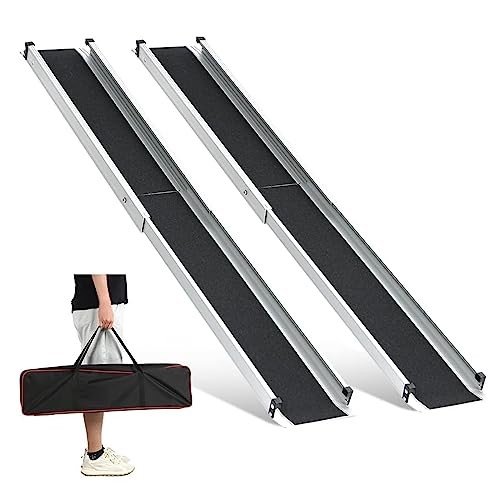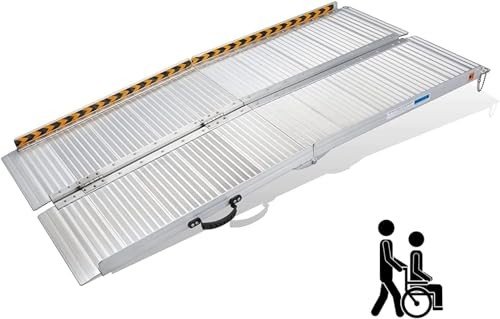
Disabled Ramps
Add a review FollowOverview
-
Founded Date November 16, 1974
-
Sectors Accounting
-
Posted Jobs 0
-
Viewed 5
Company Description
Nine Things That Your Parent Teach You About Portable Ramps For Steps
Portable Ramps for Steps: A Comprehensive Guide
Browsing through different terrains, particularly for those with mobility challenges, can often be daunting. Steps and curbs end up being barriers, making complex basic jobs like visiting good friends or running errands. Fortunately, portable ramps are here to supply a practical option. In this article, we will look into the world of portable ramps for steps, exploring their types, benefits, and crucial considerations for use.
What are Portable Ramps?
Portable ramps are lightweight, easy-to-transport devices created to provide access over steps, curbs, and other challenges. They create a gradual slope, allowing individuals using wheelchairs, scooters, or walkers to travel safely and conveniently. These ramps can be found in different sizes, designs, and materials, making it necessary to choose one that fits particular needs.

Table 1: Types of Portable Ramps
| Type of Ramp | Description | Finest Use Case |
|---|---|---|
| Folding Ramps | Ramps that can be folded for simple storage and transportation. | Home use, brief ranges |
| Roll-Up Ramps | Ramps that roll up for convenience, frequently made of resilient materials. | Travel and outdoor use |
| Strong Ramps | Non-foldable ramps made from sturdy materials, offering a steady slope. | Long-term setups |
| Threshold Ramps | Brief ramps created particularly for entrances and small steps. | Entrance use, little shifts |
| Multi-Fold Ramps | Ramps that fold in numerous ways for compact storage and versatility. | Different situations, consisting of vehicles |
Advantages of Using Portable Ramps
-
Improved Mobility: One of the main advantages of portable ramps is that they boost mobility for individuals who deal with obstacles navigating steps. Ramps provide an alternative to lifting or bring mobility gadgets up and down stairs.
-
Easy to Use: Portable ramps are usually created for fast set-up and takedown, making them user-friendly for people and caretakers alike.
-
Flexibility: Many portable ramps can be used in a range of scenarios, from homes to public spaces, and can accommodate numerous types of mobility gadgets.
-
Cost-efficient: Compared to irreversible ramp installations, portable ramps are usually a more cost-efficient solution. They enable individuals to keep self-reliance without committing to structural adjustments.
-
Transportation-Friendly: The lightweight nature and collapsible designs of portable ramps ensure they can suit the majority of vehicles, making them perfect for on-the-go users.
Kinds Of Users Benefiting from Portable Ramps
- Individuals with Disabilities: Those with mobility impairments who utilize wheelchairs or scooters.
- Aging Adults: Seniors who may experience difficulty with steps and stairs.
- Caregivers and Family Members: People assisting others with mobility concerns can take advantage of portable ramps to help with easier motion.
Things to Consider When Choosing a Portable Ramp
When selecting a portable ramp, a number of factors require to be taken into account:
Table 2: Factors to Consider
| Factor | Description |
|---|---|
| Weight Capacity | Make sure the ramp can support the weight of the user and their mobility device. |
| Length and Height | Match the ramp length to the height it requires to cover, ensuring a safe slope. |
| Product | Pick ramps made from durable products like aluminum for durability. |
| Mobility | Evaluate the ease with which the ramp can be moved and stored. |
| Surface Type | Consider ramps with slip-resistant surface areas for safety throughout usage. |
| Service warranty and Support | Look for producer guarantees and customer support alternatives. |
How to Measure for a Portable Ramp
Before buying a portable ramp, it’s important to measure both the increase (the vertical height of the steps) and the length (the horizontal range the ramp will cover). The ideal slope ratio is 1:12, implying for every inch of rise, there should be at least 12 inches of ramp run to make sure a mild slope.
Easy Measurement Guide
- Determine the Rise: Measure the vertical range from the ground to the top of the step.
- Determine the Ramp Length: Multiply the increase by 12 to find the minimum ramp length required.
- Think About Space for Storage: Ensure you have adequate space readily available for both the deployment of the ramp and its storage.
Regularly Asked Questions (FAQ)
Q1: Can portable ramps be utilized outdoors?
A1: Yes, numerous portable ramps are developed for both indoor and outside usage. Ensure that the ramp has weather-resistant products or coatings if you prepare to use it outside frequently.
Q2: Are portable ramps adjustable?
A2: Some portable ramps include adjustable heights or folding mechanisms, allowing for modification based upon the particular increase of the steps or limit.
Q3: How do I maintain my portable ramp?
A3: Regularly check your ramp for indications of wear, tidy it as needed, and store it in a safe, dry location when not in use to lengthen its life expectancy.
Q4: Where can I buy portable ramps?
A4: Portable ramps can be bought through medical supply shops, home enhancement merchants, and online marketplaces. Always inspect user reviews and specifications before making a purchase.
Q5: Can I develop a portable ramp myself?
A5: While it is possible to develop a ramp, it is advisable to buy an expertly developed ramp that fulfills security requirements to guarantee reliability and compliance with local guidelines.
Portable ramps are invaluable tools that considerably enhance the mobility and independence of individuals who face barriers due to stairs and unequal surfaces. With various designs and products available, it is vital to understand the particular requirements of the user before making a purchase. By focusing on safety, benefit, and durability, portable ramps can make daily activities accessible for everyone. Whether utilized in a home setting or on the go, a portable ramp can be an easy yet effective option for breaking down barriers in mobility.

